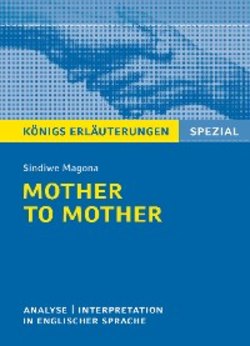Читать книгу Mother to Mother von Sindiwe Magona. Königs Erläuterungen Spezial. - Patrick Neill Charles - Страница 4
Оглавление| 1. | Das Wichtigste auf einen Blick – Schnellübersicht |
This study guide to Sindiwe Magona’s novel Mother to Mother is designed to provide an easy-to-use overview of the structure, context, themes and characters of the novel. Here is a quick rundown of the most important points.
Part 2 takes a brief look at Sindiwe Magona and her career.
Magona was born in 1943 in the village of Gungululu in South Africa. She has written a multi-volume autobiography, novels, short stories, poetry and biographies.
Mother to Mother is a semi-autobiographical fictionalised account of the murder of a white american girl (Amy Biehl) and describes the era and aftermath of apartheid in South Africa.
Part 3 offers analyses and interpretations of the novel.
Mother to Mother – Origins and sources:
The novel is set in places where Magona lived and during a time when she was also living there. It draws heavily on her own life and experience, and looks at the lives of Xhosa people in the townships of South Africa.
Summaries:
The narrator is a mother of three called Mandisa. Her eldest son Mxolisi has been involved with a group of student protesters in the township of Guguletu, near Cape Town. In August 1993 he gets caught up in a mob which assaults and kills a white girl in a car.
The novel is in the form of Mandisa’s address directly to the dead girl’s mother. She tells the story of her life and how she had Mxolisi when she was just 15. Her story covers her childhood in the slums of Blouvlei, the government-ordered forced resettlement of the people from there to the township of Guguletu near Cape Town, where families and communities were torn apart, and her struggles to raise her children. Throughout her life she and her children have been witness to and victims of racist oppression and brutality from the police. She moves back and forth in time as she tells her story, explaining how things happened the way they did.
Structure:
The novel is about the origins of events and their consequences, so it moves back and forth in time to illustrate how Mxolisi came to be the troubled, disobedient and violent young man he is in 1993. It also includes descriptions of specific episodes in South African history, as well as stories from Xhosa history and the origins of the hatred and racism in the country.
Characters:
Mandisa and her son Mxolisi are central to everything that happens and everything the novel is about.
Mandisa
the narrator, mother of three children
she became accidentally pregnant when she was 14
Mxolisi
Mandisas eldest son, who kills the white girl
Lunga and Siziwe
Mandisas second son and her daughter
China, Lungile & Dwadwa
Mandisa’s three husbands and the fathers of her children
Mandisa’s extended family (Mama, Tata, Khaya, et al.)
Other characters like Chinas family, Mandisas friends and neighbours or the white girl and her mother
Themes:
The themes we will look at in this study guide are issues of identity and inequality: violence and oppression; communities, families and traditions; and grief, guilt, hope and despair. There is a larger theme behind all of these which organises the structure of the narrative, and that is an investigation of the past.
Style and language:
The style of the novel moves between a clear and direct address (from “me” to “you”) and a richer, poetic style. The language is an interesting combination of unusual English diction and structures and a mixture of the various languages people of Mandisa’s status would speak – English, Afrikaans and Xhosa.
Interpretations:
Mother to Mother can be interpreted and read as both an informative, semi-autobiographical fictionalised account of the killing of Amy Biehl and as a look at bigger historical issues and symbolism.
